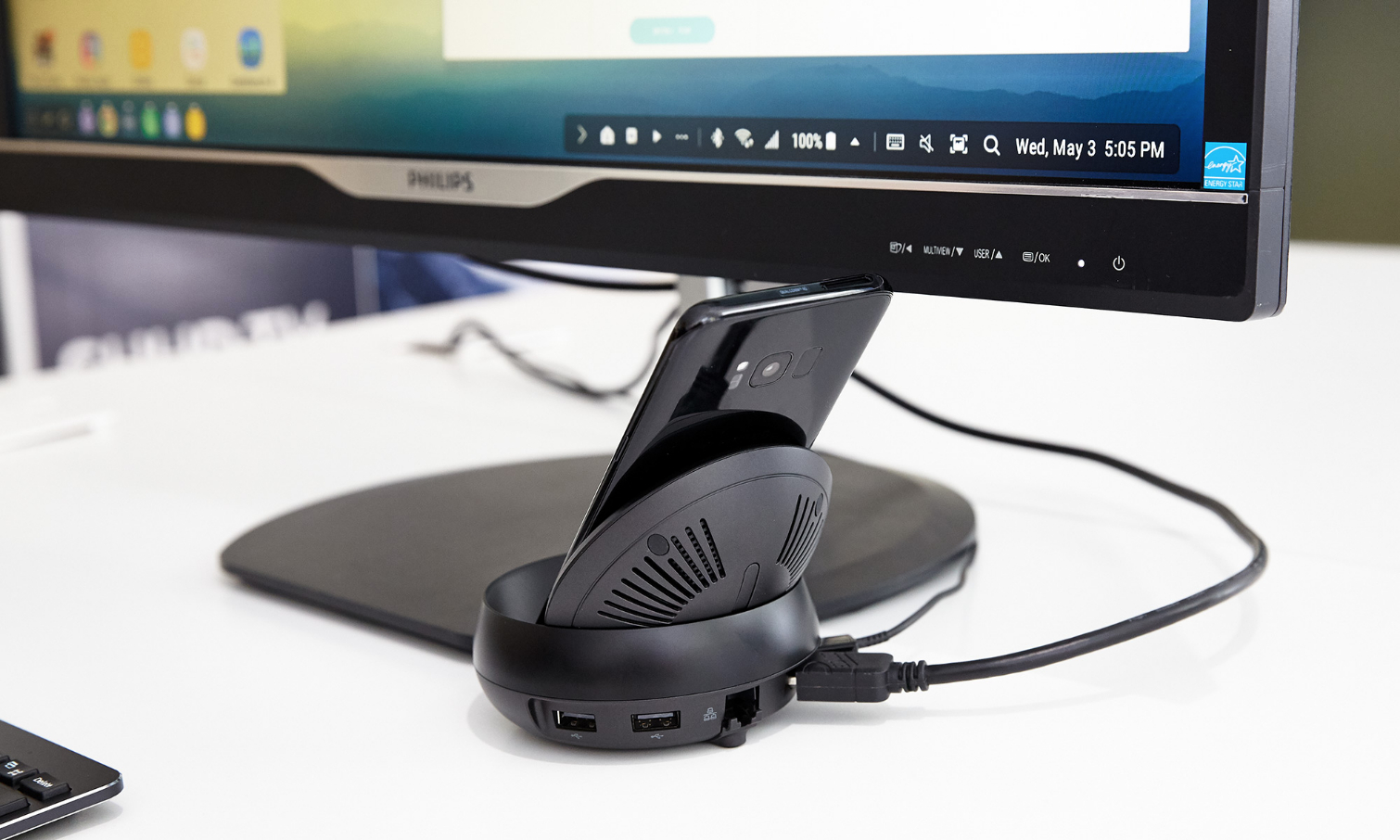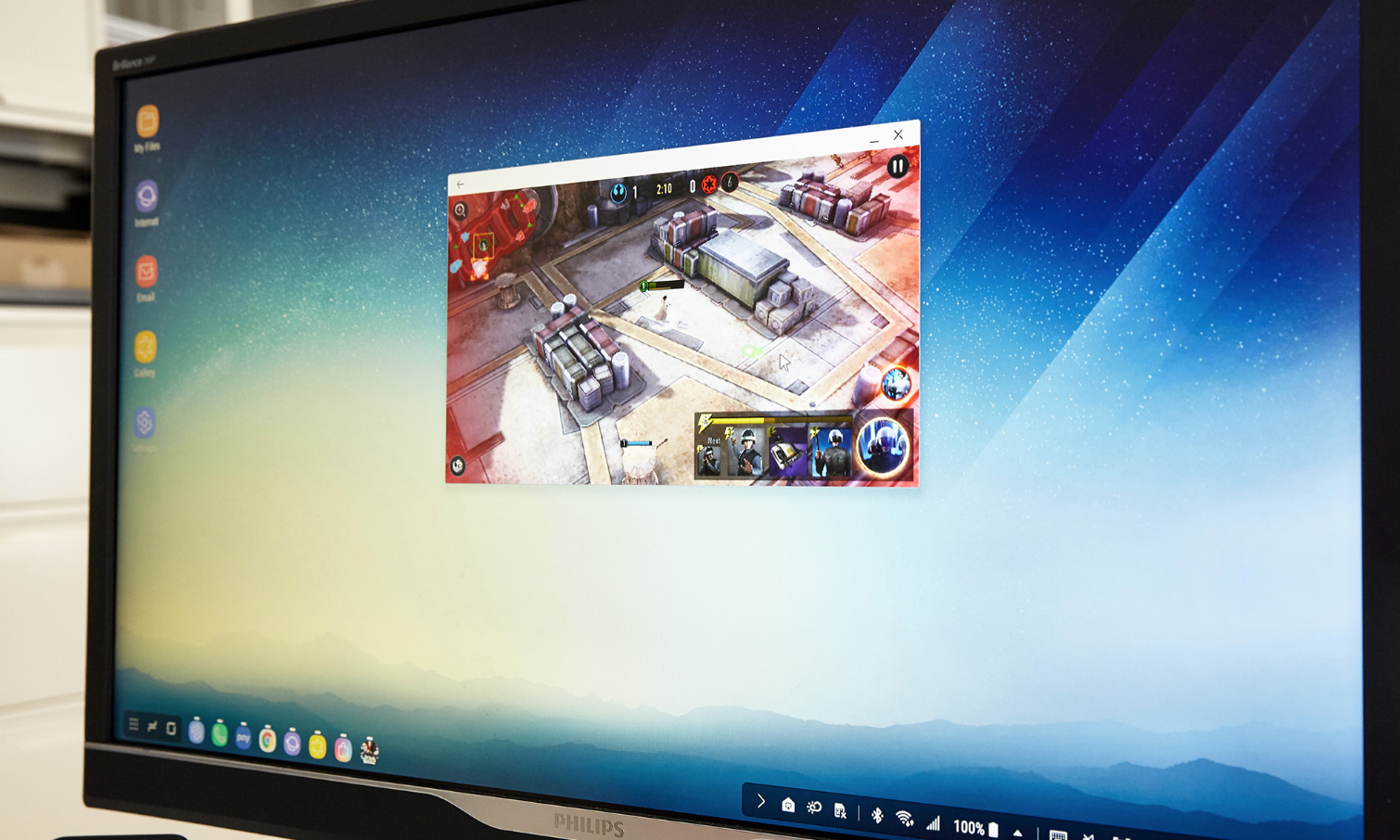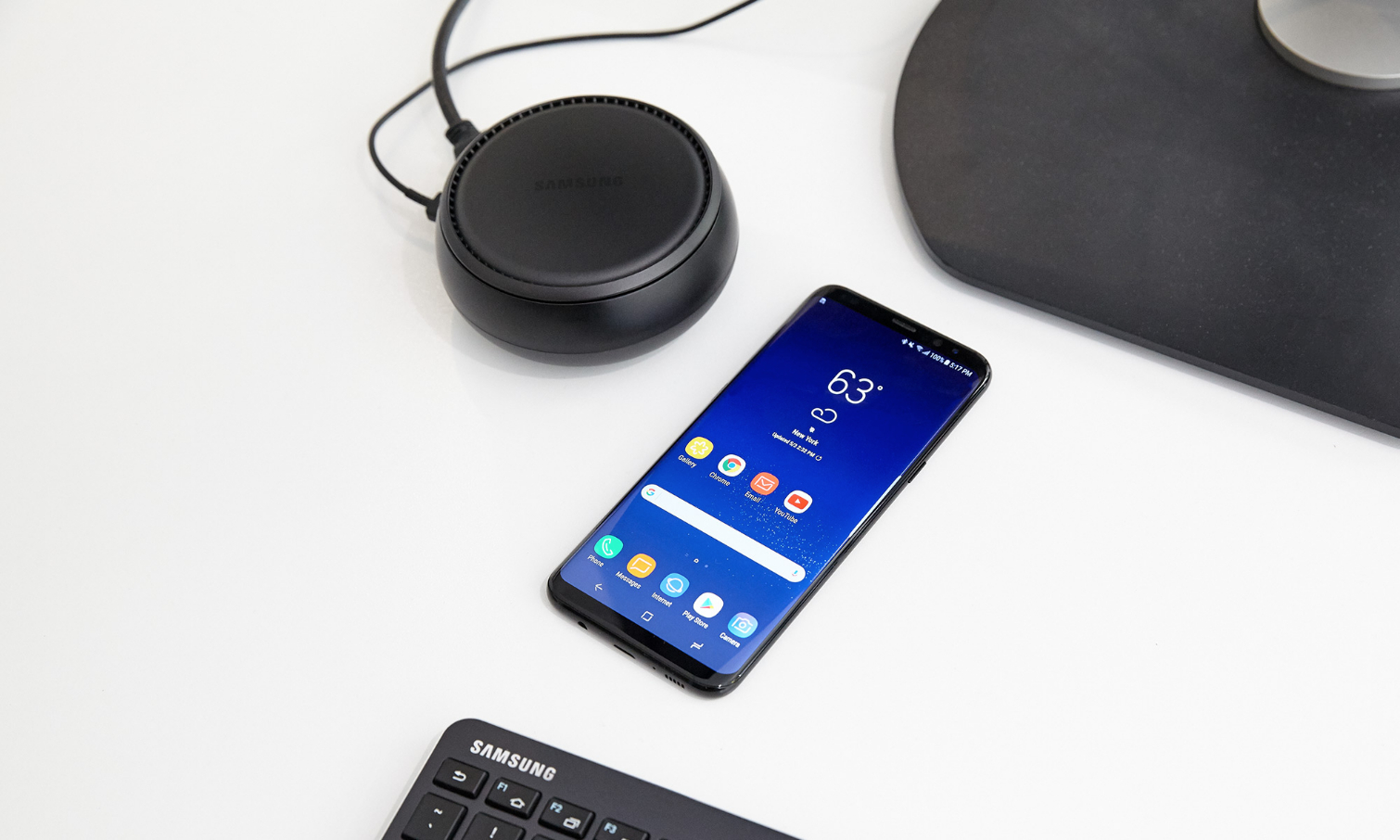Tom's Guide Verdict
Samsung's $150, puck-shaped DeX station is the slickest attempt yet at turning a phone into a desktop, but this system is definitely a work in progress.
Pros
- +
Super-simple setup
- +
Cheaper than most Chromebooks
- +
Easy to use
- +
Adds Ethernet and two USB Type-A ports
Cons
- -
Small number of officially supported apps
- -
Can't snap windows
- -
Android multitasking is still weak
- -
Images and video don't always look as sharp as they should
Why you can trust Tom's Guide
Motorola tried it with the Atrix and failed. Fujitsu thought about trying it with the Lifebook 2013 concept, and failed. And a handful of Windows Mobile phones, including the HP Elite x3, Acer Liquid Jade Primo and Microsoft Lumia 950 tried it, and haven't mustered anything more than the most lukewarm of receptions. But that's not going to stop Samsung and its new DeX Station for the Galaxy S8 from becoming the latest in a long line of devices that have tried to turn a phone into a desktop. So has the attempt actually worked this time?
Design: A black puck of connectivity

Out of the box, the DeX Station looks like an oversized hockey puck. But give the device a push on the arrow below the Samsung logo, and the top slides back to reveal a slanted rest and a single USB-C port for hooking up your Galaxy S8. Around back, the DeX sports five ports: two USB 2.0 Type-A ports, an Ethernet port, HDMI and a USB-C port.

Around back, there's a fan for keeping your S8 cool while docked, but there's not much more to the DeX design than that.
Setup: Easy as pie

Getting the DeX up and running couldn't be much simpler. Just plug in the included USB-C power adapter, connect the DeX to a nearby monitor or TV via HDMI, and then insert your phone into the DeX's cradle. In 5 to 10 seconds, you'll be greeted with a full-screen desktop that'll look familiar to anyone who has used a PC.

Just remember that if do you plan on using a Bluetooth mouse or keyboard, you'll want to pair those devices to your phone before dropping the handset on the DeX.
Once you're up and running, you can plug in additional peripherals or connect to wired internet via the Ethernet port. And if your display has built-in speakers, you can even tell the S8 to send audio to your monitor by switching output in the Settings menu. Otherwise, you'll be stuck relying on the S8 itself for audio, since the DeX's design prevents you from plugging in regular headphones or speakers.
I wish there were one extra USB Type-A port though. If you don't use a Bluetooth mouse and keyboard with the DeX, you'll be completely out of open ports. The input peripherals will occupy both Type-A ports, while the USB-C port is used to supply power to the DeX and your phone.
Interface: Desktop-lite

When you want to get down to business, you can use the handful of native Samsung apps (Gallery, Internet, Messages, etc.) found along the left side of the desktop screen. There's even an icon for the S8's file manager, which can be pretty helpful, though not as useful as it could be, since you can't drag and drop files from one app to another.
On the bottom of the screen, you'll find familiar icons for your app drawer, recent apps and home, while the center of the bottom taskbar is where you'll see all your currently open apps. Finally, in the bottom right corner, there's something that looks like an old Windows system tray, which gives you easy access to your recent notifications, quick settings and shortcuts for things like volume, search tool and device alerts.
MORE: The 10 Best Phones Available
Can DeX replace your PC?
As handy as the DeX can be, it's not really a replacement for a traditional PC or laptop. Some officially supported apps offer a similar experience to what you get on a laptop or desktop, but a lot of rough edges remain with the DeX.

When you're multitasking, windows don't snap to the sides of the screen like they would on a traditional computer, so if you want to use multiple windows at the same time, you'll spend a lot of time resizing things to fit properly on the screen. And because there's only a handful of officially supported apps, things like right-clicking and less common desktop shortcuts (like CTRL + or -) don't work across the board like you might want or expect.
In addition, you can't drag and drop files from one window to another in ways that you'd expect, such as when moving photos from the gallery into the body of an email.

The above 16 apps, along with the handful of the S8's preinstalled Samsung apps, comprise the full list apps that are currently designed to officially work with the DeX.
You can rotate or enlarge some nonsupported apps so you aren't stuck with a bunch of awkward portrait-oriented windows. But many apps can't be expanded to run in full screen, which is a real shame for games. Other apps, like Super Mario Run, don't work at all, because they don't recognize the DeX's mouse inputs during gameplay.

On the plus side, I had almost no problems using Google Docs —which isn't a fully supported app — on the DeX to write the entirety of this review. The Android version of Adobe Photoshop also worked flawlessly when I needed to edit a couple pics, and my editors were still able to ping me over HipChat, email or pretty much any other messaging app when they wanted to grab my attention. If my traditional workflow included Word, things probably would have gone even smoother, because accepting suggested changes in GDocs is way more tedious on the DeX than it would be on desktop.
Performance: Better than most Chromebooks
People have been saying for years that some smartphones are as powerful as many of the computers people have at home — if not more so in some cases. And with the Galaxy S8 packing a Qualcomm Snapdragon 835 processor, 4GB of RAM and 64GB of storage with microSD card expandability, that sentiment is pretty spot on.

With a score of 71.16 on the JetStream 1.1 JavaScript test, the S8 showed better web-browsing performance than similarly priced Chromebooks, such as the $200 Asus Chromebook C202 (48.25) and the $150 Lenovo N22 (50.8). It's not until you upgrade to Chromebooks that are in the $400 to $500 range, like the Asus Chromebook Flip C302CA, that you'll see better performance, which makes sense considering the Flip sports an Intel Core m3 CPU.
When you compare a DeX-equipped Galaxy S8 to Android-based devices like the Lenovo Yoga Book in the Geekbench 4 benchmark, which measures overall performance, the S8's score is nearly twice as high (6,134 vs 3,211).
MORE: Best Chromebooks
DeX Limitations: What needs work, what's missing
There are some downsides to the DeX compared to more traditional desktops. Videos and images don't look quite as sharp as they should when served up by a DeX-equipped S8. When I watched a game of Overwatch at 1080p/60 fps on the DeX next to an all-in-one PC playing the same video, the DeX's clip looked blurrier and had more artifacting than when I watched the same clip on the nearby all-in-one PC. Additionally, aliasing on text makes letters look more jagged on the DeX and decreases readability a bit.

There are also some annoying limitations with DeX. You can't play two games at the same time — not because the S8 can't handle it, but because Android won't let you. However, if you just want to have multiple web pages, a Word doc, Twitter and Spotify all going at the same time, a DeXed S8 will serve you just fine. You can even have YouTube playing off on the side at the same time, with almost no impact on performance. (You will need YouTube Red, since that's the only way to get YouTube to play in the background while you're multitasking, although even YouTube isn't always reliable.)
Another restriction of the DeX is that even though the S8 features a 2960 x 1440 WQHD+ display, the system can output a max resolution of 1920 x 1080. With the extra horsepower needed to push that many pixels, I can understand the choice to limit the DeX to full HD. But still, support for higher-resolution images would have been nice.
Is DeX Good for Business?
Theoretically, the DeX could be a less expensive way to outfit employees with computers, except that it would require companies to have a mobile-first strategy for equipment, something that's still pretty rare in a time when most business hand out laptops and call it a day.

Otherwise, because of the difference in OSes and app support, you'd run into situations where certain types of software — like VPNs, single sign-on tools and others— won't work properly on a DeXed S8. And employees would still need a DeX-like laptop shell when they want to work on their phones away from a desk with a monitor setup, which makes this prospect more theoretical than an actual option.
So what is it good for?
The DeX could be a decent limted-time replacement for a desktop when you don't need a ton of performance. But after a while, most people would probably get fed up and want to go back to their regular setups.
Instead, the DeX's most interesting function might be as a gaming accessory. Not only does it give you a supereasy way to throw your games up on a big screen, but adding mouse and keyboard controls to certain games can also give you a legitimate competitive advantage over those trying to smash the screen with their fingers. That's true for titles like Star Wars Force Arena, Marvel Future Fight and especially Vainglory (which is one of the few games that supports both mouse inputs and full-screen view). And with the DeX's Ethernet jack, you could even stream your gaming exploits out to YouTube or Twitch over wired Ethernet for a much more reliable connection than you'd get on Wi-Fi or 4G LTE.

The DeX is also a good alternative for an S8 owner considering getting a Chromebook, especially if there’s already a spare monitor lying around. At $150, The DeX is cheaper than most Chromebooks, while offering similar performance, as good if not better app support and the benefit of not forcing you to learn a new OS. However, your ability to use browser extensions will be quite restricted, as the mobile version of the Chrome browser doesn't support them and Samsung's own browser doesn't support anywhere near the same number of extensions that you get in full versions of Chrome.
MORE: Smartphones with the Longest Battery Life
Bottom Line
With all the rough edges, weird limitations, and occasionally blurry text and video with this system, I wouldn't call the DeX an unmitigated success. Samsung needs to figure out how to better control the sizes and locations of each window, while also offering more ports, improved multitasking and better support for all the various apps people have on their phones. And if Samsung wants to prop up the Galaxy S8 as a true PC replacement, the company will have to fill in the gap that's left by the lack of a DeX laptop shell; no one wants to drag a monitor on an airplane or bus.
However, Samsung should be applauded for producing the best example yet of why people would want turn their phones into desktops. And if you've got some old desktop accessories lying around, the DeX is a great reason to recycle some tech. In the end, the $150 Samsung DeX adds a lot of functionality to an already-great device, but it's still far from anything we'd call essential.
Sam is a Senior Writer at Engadget and previously worked at Gizmodo as a Senior Reporter. Before that, he worked at Tom's Guide and Laptop Mag as a Staff Writer and Senior Product Review Analyst, overseeing benchmarks and testing for countless product reviews. He was also an archery instructor and a penguin trainer too (really).

